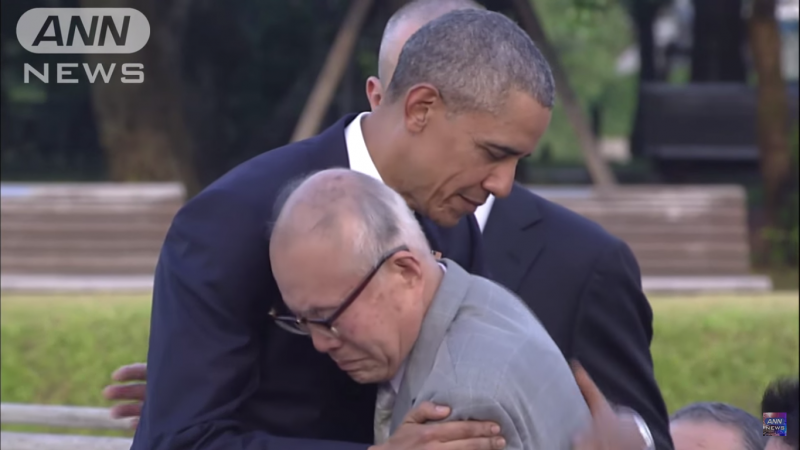
Iconic image of Obama comforting Mori Shigeaki [1], a hibakusha A-bomb survivor at Hiroshima Peace Memorial Park on Friday, May 27. Screencap from ANN [2].
Following President Barack Obama's historic visit to the Hiroshima Peace Memorial Park [3] in Japan on May 27, a nationwide poll conducted by Kyodo News [4] showed that 98% of Japanese respondents viewed the American president's visit to Hiroshima positively. In the poll, 74.5% of respondents accepted the fact there was no apology for the 1945 atomic bombings.
This was the first time a US president had visited Hiroshima since the city was destroyed by an American atomic bomb on August 6, 1945 [5].
While there was some debate [6] that Obama's visit to Hiroshima was intended to be an apology [7] for the destruction inflicted on Hiroshima, the president's trip was intended to recognize what had happened more than seventy years before, and also make a plea for nuclear non-proliferation.
About 30% of the population [8] of Hiroshima was killed by the blast the subsequent firestorm that raged through the city. At least 140,000 people [8] would die as a result of the bombing by the end of 1945.
The sheer scope and violence of the destruction that occurred at Hiroshima, and then again three days later at Nagasaki [9] on August 9 has ignited a debate about whether or not the bombing of Hiroshima and Nagasaki should be considered war crimes [10], acts of state terror [11] or a pragmatic way [12] to end the Pacific War and spare human life.
How hard can it be to say “sorry”?
Obama's historic visit to Hiroshima occurred after a G7 meeting in Japan [13], and followed US Secretary of State John Kerry's visit [14] to the city on April 11, as well US Ambassador to Japan Caroline Kennedy's equally unprecedented visit [15] in 2015.
President Obama's visit to Hiroshima Peace Memorial Park included a wreath-laying ceremony, a short speech and an exchange with hibakusha, the survivors of the atomic bombing.
Cables leaked by Wikileaks in 2011 [16] show that there has long been strong opposition [16] by American officials to a visit by President Obama to Hiroshima. According to the Asahi Shimbun [1] and other news outlets, US officials were extremely anxious that any exchanges between Obama and survivors of the atomic bombing not leave the impression that an apology of any kind was involved.
Instead, the meeting produced the iconic image of American President Obama hugging Mori Shigeaki [1], a survivor of the American bombing who went on to research and track down the fate of American prisoners of war [1] who were in Hiroshima at the time of the Aug. 6, 1945, bombing and died as a result.
謝罪の言葉はなくとも
この行動に全てがつまってると感じた#Hiroshima [17] pic.twitter.com/w8c6ZKX5dk [18]— 泰志 (@IamT81N) May 27, 2016 [19]
While there were no words of apology, this one act expresses the feelings everyone has (on this day).
Many Japanese newspapers [20] reprinted the full text of Obama's speech in Hiroshima [21], which in part calls for the abolition of nuclear weapons:
But among the nations, like my own, that hold nuclear stockpiles, we must have the courage to escape the logic of fear and pursue a world without them. We may not realize this goal in my lifetime, but persistent effort can roll back the possibility of catastrophe.
Japanese people rate Obama's Hiroshima visit a success
Cabinet's support rating jumps to 55.3% but Obama speech wows 98%: survey | The Japan Times https://t.co/N5Pw1fiSFM [22]
— Ayako Mie (@jt_ayakomie) May 30, 2016 [23]
Not everyone was satisfied with President Obama's visit. For example, atomic bomb victims in Nagasaki, which was also attacked in August 1945, said they wished the president would have visited their city too.
まもなくオバマ大統領が広島訪問しますが、もう一つの被爆地、長崎市の平和公園にも朝から多くの人が訪れています。平和公園では核廃絶の集会が開かれ、原爆犠牲者の冥福を祈り黙とう。被爆者の男性は「長崎にも来てほしい」と訴えました(博) pic.twitter.com/QwhOxetvmA [24]
— 日経新聞写真部 (@nikkeiphoto) May 27, 2016 [25]
Although President Obama will shortly begin his visit to Hiroshima, people have been gathering since morning in a Peace Park in Nagasaki, the other city that was bombed in 1945. Those gathered in Nagasaki are calling for an end to nuclear weapons, and are praying to the victims of the atom bomb. One hibakusha says he wishes Obama would also have come to Nagasaki.
As well, surviving Korean hibakusha pressed for a formal apology from the United States, along with a visit to the A-Bomb cenotaph in South Korea [26]. Korea was a Japanese colony at the time of the bombing, and at least 70,000 to 100,000 Koreans were in Hiroshima and Nagasaki [27] when the bombs fell.
Re: 朝日新聞:#Obama [28] visit progress but not enough, #Korean [29] #hibakusha [30] say #Hiroshima [17]https://t.co/7EXtBaB99w [31] pic.twitter.com/Ani8KdgnXV [32]
— 河内丸(裁判員制度を即時廃止せよ) (@Kawachi_Maru) May 28, 2016 [33]
Some Japanese Twitter users wondered why President Obama only spent ten minutes visiting the Hiroshima Peace Memorial Museum [34] following the ceremony at the Peace Park:
オバマ大統領、原爆資料館には10分くらいいたらしいけど…ちょっと短すぎない?そんな短時間で何を見れたんやろ…
— あんみつ@miwaいきもの (@ikkii441) May 27, 2016 [35]
President Obama only spent ten minutes in the Hiroshima Peace Memorial Museum… wasn't his visit a little bit short? What could he possibly have seen in so short a time?
However, Twitter user @satoss_kiki [36]‘s reflections on the perceived shortness of Obama's visit inside the museum went viral.
Although the self-described “housewife from the sticks” (田舎のおばちゃん, inaka no obachan) has just 263 followers on Twitter, her rebuttal to the idea that Obama's visit to the museum was overly short was retweeted nearly 30,000 times:
原爆資料館をたった10分で出てきて、正直意味あるの?と思ったが、何がなんでも行きたいと言って無理矢理ねじ込んだ10分だったというアナウンサーの言葉を聞いて、こういう報道は大事だと思った。「たかだか10分」じゃなくて「どうにか10分」だったんだよね。
— さと (@satoss_kiki) May 27, 2016 [37]
While you may think that the President's ten-minute to the museum was meaningless, but keep in mind that Obama despite his busy schedule he managed to make time to go there. It wasn't “just ten minutes” to the President.